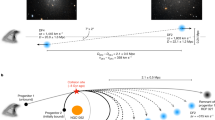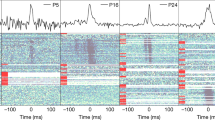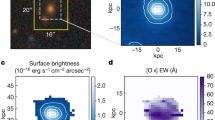Abstract
Galaxies and groups of galaxies exist in dark-matter haloes filled with diffuse gas. The diffuse gas represents up to 80% of the mass in baryonic matter within the haloes1,2, but is difficult to detect because of its low density (particle number densities of ≲10−4 cm−3) and high temperature (mostly >106 K). Here we analyse the impact of diffuse gas associated with nearby galaxies using the dispersion measures (DMs) of extragalactic fast radio bursts (FRBs). FRB DMs provide direct measurements of the total ionized-gas contents along their sightlines. Out of a sample of 474 distant FRBs from the Canadian Hydrogen Intensity Mapping Experiment (CHIME) FRB Catalog 1 (ref. 3), we identify a subset of events that probably intersect the dark-matter haloes of galaxies in the local Universe (<40 Mpc). The mean DM of the galaxy-intersecting FRBs is larger than that of the non-intersecting FRBs with a probability >0.99 and the excess DM is >90 pc cm−3 with >95% confidence. The excess is larger than expected for the diffuse gas surrounding isolated galaxies, but may be explained by additional contributions from gas surrounding galaxy groups, including from the Local Group. This result demonstrates the predicted ability of FRBs to be used as sensitive, model-independent measures of the diffuse gas contents of dark-matter haloes4,5,6,7.
This is a preview of subscription content, access via your institution
Access options
Access Nature and 54 other Nature Portfolio journals
Get Nature+, our best-value online-access subscription
$29.99 / 30 days
cancel any time
Subscribe to this journal
Receive 12 digital issues and online access to articles
$119.00 per year
only $9.92 per issue
Buy this article
- Purchase on Springer Link
- Instant access to full article PDF
Prices may be subject to local taxes which are calculated during checkout



Similar content being viewed by others
Data availability
All the data used in these analyses are publicly available. CHIME/FRB Catalog 1 can be found at https://www.chime-frb.ca/catalog. The GWGC can be downloaded at http://vizier.u-strasbg.fr/viz-bin/VizieR?-source=GWGC.
Code availability
This research made use of the open-source hmf, NFW, CHIME/FRB’s cfod package and frb (https://github.com/FRBs/FRB/tree/main/frb) python packages. All custom code used in our analysis is available from the corresponding author upon request.
References
Anderson, M. E. & Bregman, J. N. Do hot halos around galaxies contain the missing baryons? Astrophys. J. 714, 320–331 (2010).
Tumlinson, J., Peeples, M. S. & Werk, J. K. The circumgalactic medium. Annu. Rev. Astron. Astrophys. 55, 389–432 (2017).
Amiri, M. et al. The first CHIME/FRB fast radio burst catalog. Astrophys. J. Suppl. Ser. 257, 59 (2021).
McQuinn, M. Locating the “missing” baryons with extragalactic dispersion measure estimates. Astrophys. J. Lett. 780, L33 (2014).
Ravi, V. Measuring the circumgalactic and intergalactic baryon contents with fast radio bursts. Astrophys. J. 872, 88 (2019).
Prochaska, J. X. & Zheng, Y. Probing galactic haloes with fast radio bursts. Mon. Not. R. Astron. Soc. 485, 648–665 (2019).
Madhavacheril, M. S., Battaglia, N., Smith, K. M. & Sievers, J. L. Cosmology with the kinematic Sunyaev-Zeldovich effect: breaking the optical depth degeneracy with fast radio bursts. Phys. Rev. D 100, 103532 (2019).
Bandura, K. et al. Canadian Hydrogen Intensity Mapping Experiment (CHIME) pathfinder. In Ground-based and Airborne Telescopes V Conference Series Vol. 9145 (eds Stepp, L. M. et al.) 914522 (SPIE, 2014).
Kaspi, V. M. & CHIME/FRB Collaboration. The CHIME Fast Radio Burst Project. In American Astronomical Society Meeting Abstracts Vol. 229, 242.19 (American Astronomical Society, 2017).
Rafiei-Ravandi, M. et al. CHIME/FRB catalog 1 results: statistical cross-correlations with large-scale structure. Astrophys. J. 922, 42 (2021).
Shull, J. M. & Danforth, C. W. The dispersion of fast radio bursts from a structured intergalactic medium at redshifts z < 1.5. Astrophys. J. Lett. 852, L11 (2018).
Macquart, J. P. et al. A census of baryons in the Universe from localized fast radio bursts. Nature 581, 391–395 (2020).
Prochaska, J. X. et al. The low density and magnetization of a massive galaxy halo exposed by a fast radio burst. Science 365, aay0073 (2019).
Connor, L. et al. A bright, high rotation-measure FRB that skewers the M33 halo. Mon. Not. R. Astron. Soc. 499, 4716–4724 (2020).
Eftekhari, T. & Berger, E. Associating fast radio bursts with their host galaxies. Astrophys. J. 849, 162 (2017).
Aggarwal, K. et al. Probabilistic association of transients to their hosts (PATH). Astrophys. J. 911, 95 (2021).
White, D. J., Daw, E. J. & Dhillon, V. S. A list of galaxies for gravitational wave searches. Classic. Quant. Grav. 28, 085016 (2011).
Cordes, J. M. NE2001: a new model for the galactic electron density and its fluctuations. In Milky Way Surveys: The Structure and Evolution of Our Galaxy Conference Series Vol. 317 (eds Clemens, D. et al.) 211–216 (Astronomical Society of the Pacific, 2004).
Yao, J. M., Manchester, R. N. & Wang, N. A new electron-density model for estimation of pulsar and FRB distances. Astrophys. J. 835, 29 (2017).
Prochaska, J. X. & Neeleman, M. The astrophysical consequences of intervening galaxy gas on fast radio bursts. Mon. Not. R. Astron. Soc. 474, 318–325 (2018).
Yang, X. et al. Galaxy groups in the SDSS DR4. I. the catalog and basic properties. Astrophys. J. 671, 153–170 (2007).
Mulchaey, J. S. X-ray properties of groups of galaxies. Annu. Rev. Astron. Astrophys. 38, 289–335 (2000).
Stocke, J. T. et al. Absorption-line detections of 105–106 K gas in spiral-rich groups of galaxies. Astrophys. J. 791, 128 (2014).
Planck Collaboration et al. Planck intermediate results. XI. The gas content of dark matter halos: the Sunyaev-Zeldovich-stellar mass relation for locally brightest galaxies. Astron. Astrophys. 557, A52 (2013).
Oppenheimer, B. D., Babul, A., Bahé, Y., Butsky, I. S. & McCarthy, I. G. Simulating groups and the intragroup medium: the surprisingly complex and rich middle ground between clusters and galaxies. Universe 7, 209 (2021).
Fujita, Y., Akahori, T., Umetsu, K., Sarazin, C. L. & Wong, K.-W. Probing WHIM around galaxy clusters with fast radio bursts and the Sunyaev-Zel’dovich effect. Astrophys. J. 834, 13 (2017).
Qu, Z., Huang, R., Bregman, J. N. & Li, J.-T. An X-ray- and SZ-bright diffuse source toward M31: a local hot bridge. Astrophys. J. 907, 14 (2021).
Hao, J. et al. VizieR Online Data Catalog: GMBCG galaxy cluster catalog from SDSS DR7 (Hao+, 2010). VizieR Online Data Catalog J/ApJS/191/254 (2013); https://vizier.cds.unistra.fr/viz-bin/VizieR?-source=J/ApJS/191/254
Lu, W. & Piro, A. L. Implications from ASKAP fast radio burst statistics. Astrophys. J. 883, 40 (2019).
Gardenier, D. W., Connor, L., van Leeuwen, J., Oostrum, L. C. & Petroff, E. Synthesising the repeating FRB population using frbpoppy. Astron. Astrophys. 647, A30 (2021).
Keating, L. C. & Pen, U.-L. Exploring the dispersion measure of the Milky Way halo. Mon. Not. R. Astron. Soc. 496, L106–L110 (2020).
Bland, M. An Introduction to Medical Statistics (Oxford Univ. Press, 1995).
Lehmann, E. & D’Abrera, H. Nonparametrics: Statistical Methods Based on Ranks (Prentice Hall, 1998).
Shull, J. M., Smith, B. D. & Danforth, C. W. The baryon census in a multiphase intergalactic medium: 30% of the baryons may still be missing. Astrophys. J. 759, 23 (2012).
Planck Collaboration et al. Planck 2018 results. VI. Cosmological parameters. Astron. Astrophys. 641, A6 (2020).
Bregman, J. N. et al. The extended distribution of baryons around galaxies. Astrophys. J. 862, 3 (2018).
Lim, S. H., Mo, H. J., Wang, H. & Yang, X. Detection of missing baryons in galaxy groups with kinetic Sunyaev-Zel’dovich effect. Astrophys. J. 889, 48 (2020).
Shull, J. M. Where do galaxies end? Astrophys. J. 784, 142 (2014).
Jones, C. & Forman, W. The structure of clusters of galaxies observed with Einstein. Astrophys. J. 276, 38–55 (1984).
Miller, M. J. & Bregman, J. N. Constraining the Milky Way’s hot gas halo with O VII and O VIII emission lines. Astrophys. J. 800, 14 (2015).
Watkins, L. L., van der Marel, R. P., Sohn, S. T. & Evans, N. W. Evidence for an intermediate-mass milky way from gaia DR2 halo globular cluster motions. Astrophys. J. 873, 118 (2019).
Karachentsev, I. D., Karachentseva, V. E., Huchtmeier, W. K. & Makarov, D. I. A catalog of neighboring galaxies. Astron. J. 127, 2031–2068 (2004).
Davé, R. et al. SIMBA: cosmological simulations with black hole growth and feedback. Mon. Not. R. Astron. Soc. 486, 2827–2849 (2019).
Springel, V. et al. First results from the IllustrisTNG simulations: matter and galaxy clustering. Mon. Not. R. Astron. Soc. 475, 676–698 (2018).
Schaye, J. et al. The EAGLE project: simulating the evolution and assembly of galaxies and their environments. Mon. Not. R. Astron. Soc. 446, 521–554 (2015).
Tremmel, M. et al. The Romulus cosmological simulations: a physical approach to the formation, dynamics and accretion models of SMBHs. Mon. Not. R. Astron. Soc. 470, 1121–1139 (2017).
Walker, C. R. H., Ma, Y.-Z. & Breton, R. P. Constraining the redshifts of unlocalised fast radio bursts. Astron. Astrophys. 638, A37 (2020).
Shannon, R. M. et al. The dispersion–brightness relation for fast radio bursts from a wide-field survey. Nature 562, 386–390 (2018).
James, C. W. et al. The fast radio burst population evolves, consistent with the star formation rate. Mon. Not. R. Astron. Soc. 510, L18–L23 (2022).
James, C. W. et al. The z-dm distribution of fast radio bursts. Mon. Not. R. Astron. Soc. 509, 4775–4802 (2022).
Niu, C.-H. et al. CRAFTS for fast radio bursts: extending the dispersion-fluence relation with new FRBs detected by FAST. Astrophys. J. Lett. 909, L8 (2021).
Heintz, K. E. et al. Host galaxy properties and offset distributions of fast radio bursts: implications for their progenitors. Astrophys. J. 903, 152 (2020).
Connor, L. Interpreting the distributions of FRB observables. Mon. Not. R. Astron. Soc. 487, 5753–5763 (2019).
Simard, D. & Ravi, V. Measuring interstellar turbulence in fast radio burst host galaxies. Preprint at https://arxiv.org/abs/2107.11334 (2021).
Niu, C. H. et al. A repeating fast radio burst in a dense environment with a compact persistent radio source. Preprint at https://arxiv.org/abs/2110.07418 (2021).
Kourkchi, E. & Tully, R. B. Galaxy groups within 3500 km s−1. Astrophys. J. 843, 16 (2017).
Acknowledgements
We thank C. Hummels, W. Lu, J. M. Shull and the Caltech FRB group for helpful discussions. We also thank C. Leung, K. Masui and M. Bhardwaj for valuable comments on the manuscript. This research was partially supported by the National Science Foundation under grant number AST-1836018.
Author information
Authors and Affiliations
Contributions
V.R. conceived of searching only nearby foreground galaxies for FRB–halo intersections. L.C. developed the methods for cross-matching the catalogues, statistically testing the DM distributions and analysing the DM excess that are reported in Figs. 1–3 and the results. V.R. modelled the halo DM contribution shown in Extended Data Fig. 3. L.C led the writing of the manuscript in close collaboration with V.R.
Corresponding author
Ethics declarations
Competing interests
The authors declare no competing interests.
Peer review
Peer review information
Nature Astronomy thanks Masoud Rafiei-Ravandi and the other, anonymous, reviewer(s) for their contribution to the peer review of this work.
Additional information
Publisher’s note Springer Nature remains neutral with regard to jurisdictional claims in published maps and institutional affiliations.
Extended data
Extended Data Fig. 1 A simulation of CHIME/FRB DMs to compare the statistical power and appropriateness of three tests: Student’s one-sided t-test, our jackknife test, and the Kolmogorov-Smirnov (KS) test.
We simulate 474 FRB DMs with a similar distribution to the CHIME/FRB sources. In the top row, we have not added any excess DM to the galaxy-intersecting sources. In the bottom row, excess DM has been added to the 25 simulated FRBs that intersect a foreground galaxy, with a normal distribution of mean 150 pc cm−3 and standard deviation 50 pc cm−3. From the top row, we see that none of the tests produces spurious low p-values and their p-values are uniform as expected. The bottom right panel demonstrates that the KS-test is less sensitive to DM offsets than the t-test and the non-parametric jackknife test. The t-test and jackknife tests are one-sided, in that they explicitly look for a positive mean DM difference, whereas the KS test measures if the two samples were drawn from different distributions and does not make that distinction.
Extended Data Fig. 2 Predicted DM excesses for CHIME/FRB galaxy intersections assuming isolated galaxy halos.
The histograms show the relative binned counts of DMs accrued by the fiducial sample of 26 FRBs with b⊥ < 200 kpc. Two models for the radial density distribution of the CGM are shown: a ‘beta’ model with β = 0.5, and a modified NFW model. Results are shown in blue and orange respectively. The mean DMs of the data shown in each histogram are noted in the figure legend.
Extended Data Fig. 3 Predicted DM excesses for 26 FRBs intersecting halos of different masses.
Top: We use a ‘beta’ model with β = 0.5 and a modified NFW model for the radial density distribution. Results are shown in blue and orange respectively. For each halo mass, 1σ error ranges are shown based on 100 simulations of samples of 26 FRB intersections within the virial radii. The FRB positions relative to the halo centres are simulated using the offsets and CHIME/FRB Catalog 1 position uncertainties of the 26 FRBs in Table 1. The grey shaded area indicates the likely (95% confidence) DM excess. fgas = 1 is assumed. Bottom: Same as top, but with values of fgas specific to each halo mass derived from four cosmological simulations (see text for details). A modified NFW radial-density model is assumed.
Rights and permissions
About this article
Cite this article
Connor, L., Ravi, V. The observed impact of galaxy halo gas on fast radio bursts. Nat Astron 6, 1035–1042 (2022). https://doi.org/10.1038/s41550-022-01719-7
Received:
Accepted:
Published:
Issue Date:
DOI: https://doi.org/10.1038/s41550-022-01719-7
This article is cited by
-
Cosmic ray feedback in galaxies and galaxy clusters
The Astronomy and Astrophysics Review (2023)



